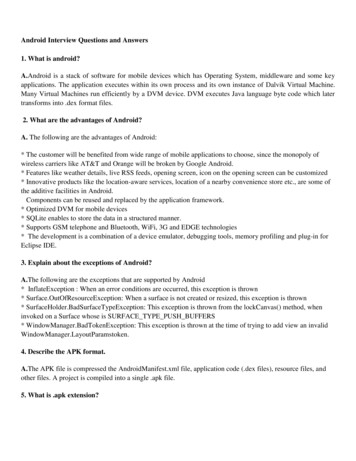
Transcription
Android Interview Questions and Answers1. What is android?A.Android is a stack of software for mobile devices which has Operating System, middleware and some keyapplications. The application executes within its own process and its own instance of Dalvik Virtual Machine.Many Virtual Machines run efficiently by a DVM device. DVM executes Java language byte code which latertransforms into .dex format files.2. What are the advantages of Android?A. The following are the advantages of Android:* The customer will be benefited from wide range of mobile applications to choose, since the monopoly ofwireless carriers like AT&T and Orange will be broken by Google Android.* Features like weather details, live RSS feeds, opening screen, icon on the opening screen can be customized* Innovative products like the location-aware services, location of a nearby convenience store etc., are some ofthe additive facilities in Android.Components can be reused and replaced by the application framework.* Optimized DVM for mobile devices* SQLite enables to store the data in a structured manner.* Supports GSM telephone and Bluetooth, WiFi, 3G and EDGE technologies* The development is a combination of a device emulator, debugging tools, memory profiling and plug-in forEclipse IDE.3. Explain about the exceptions of Android?A.The following are the exceptions that are supported by Android* InflateException : When an error conditions are occurred, this exception is thrown* Surface.OutOfResourceException: When a surface is not created or resized, this exception is thrown* SurfaceHolder.BadSurfaceTypeException: This exception is thrown from the lockCanvas() method, wheninvoked on a Surface whose is SURFACE TYPE PUSH BUFFERS* WindowManager.BadTokenException: This exception is thrown at the time of trying to add view an invalidWindowManager.LayoutParamstoken.4. Describe the APK format.A.The APK file is compressed the AndroidManifest.xml file, application code (.dex files), resource files, andother files. A project is compiled into a single .apk file.5. What is .apk extension?
A.The extension for an Android package file, which typically contains all of the files related to a single Androidapplication. The file itself is a compressed collection of an AndroidManifest.xml file, application code (.dexfiles), resource files, and other files. A project is compiled into a single .apk file.6. What is .dex extension?A.Android programs are compiled into .dex (Dalvik Executable) files, which are in turn zipped into a single.apk file on the device. .dex files can be created by automatically translating compiled applications written inthe Java programming language.7. Explain the Architecture of Android ?A. Top - Applications (Contacts, Browser, Phone, etc)Below Applications - Application Framework(Activity Manager, Window Manager, Content Providers, ViewSystem, Package manager,Telephony manager, Resource, Notification, Location managers)Below Application Framework - System Libraries(Like Sqlite, webkit, SSL, OpenGL, Media Framework etc)& Android Runtime( Core Libraries and DVM).Atlast Last - Linux Kernel (which composed of drivers like display, camera etc.)10. What is an activity?A. A single screen in an application, with supporting Java code.An activity presents a visual user interface for one focused endeavor the user can undertake.For example, an activity might present a list of menu items users can choose from or it might displayphotographs along with their captions.11. What is a service?A.A service doesn’t have a visual user interface, but rather runs in the background for an indefinite period oftime.For example, a service might play background music as the user attends to other matters, or it might fetch dataover the network or calculate something and provide the result to activities that need it.Each service extends theService base class.12. How to Remove Desktop icons and Widgets?
A. Press and Hold the icon or widget. The phone will vibrate and on the bottom of the phone you will seeanoption to remove. While still holding the icon or widget drag it to the remove button. Once remove turns reddrop the item and it is gone13. Describe a real time scenario where android can be used?A .Imagine a situation that you are in a country where no one understands the language you speak and you cannot read or write. However, you have mobile phone with you.14. How to select more than one option from list in android xml file? ********A. Give an example.Specify android id, layout height and width as depicted in the following example.15. What languages does Android support for application development?A.Android applications are written using the Java programming language.16. Describe Android Application Architecture?A.Android Application Architecture has the following components: Services – like N Intent – To perform inter-communication network Operation between activities or services Resource Externalization – such as strings and graphics Notification signaling users – light, sound, icon, notification, dialog etc17. What is the Android Open Source Project?A. We use the phrase “Android Open Source Project” or “AOSP” to refer to the people, the processes, and thesource code that make up Android.18. Why did we open the Android source code?A .Google started the Android project in response to our own experiences launching mobile apps. We wantedto make sure that there would always be an open platform available for carriers, OEMs, and developers to use tomake their innovative ideas a reality. We also wanted to make sure that there was no central point of failure, sothat no single industry player could restrict or control the innovations of any other. The single most importantgoal of the Android Open-Source Project (AOSP) is to make sure that the open-source Android software isimplemented as widely and compatibly as possible, to everyone’s benefit.
19. What is the Guardian app for Android?A.The Guardian app for Android delivers all the best content from guardian.co.uk to your phone or tablet. Readthe latest news, sport, comment and reviews, watch video, listen to brodcasts and browse stunning picturegalleries while on the move.20. What features does it have?A .- Navigate by section, topic or contributor- Download your homepage and favourites for offline reading with the touch of a button, or schedule adaily download for a time that suits you- Browse our award-winning audio and video content- Save contributors, topics and sections to your favourites folder- Add favourites to your homescreen with an expanded view or link- Swipe through stunning full-screen picture galleries- Share articles and galleries via the Android share function- View content in portrait or landscape orientation21. Will it work on my phone?A.The app will work on all phones and tablets running Android version 1.6 and above.22. How much does it cost?A.The app is free and ad-supported.23. How do I save the app to my SD card?A. From the device's Settings menu, go to Applications Manage applications The Guardian. Under the dataheader, choose "Move to SD card".24. How do I add sections to my favourites?A. It is possible to add sections, topics and contributors to your favourites. You can add to favourites bytapping the star icon in the top right hand corner of the relevant screens, or on the right hand side of the headersin the all sections menu.
25. How do I remove sections from my favourites?A. From the favourites menu, tap the red icons to the left hand side of the items. Alternatively, tap the star iconin the top right hand corner of the relevant screen so that it returns to its white state.26. What is Mono for Android?A. Mono for Android is a software development kit that allows developers to use the C# language to createmobile applications for Android-based devices.Mono for Android exposes two sets of APIs, the core .NET APIsthat C# developers are familiar with as well as a C# binding to Android's native APIs exposed through theMono.Android.* namespace.You can use Mono for Android to develop applications that are distributed throughthe Android Application Stores or to deploy software to your personal hardware or the Android simulator.27. What is included in Mono for Android?A. Mono for Android consists of the core Mono runtime, the Mono for Android bindings to the native AndroidAPIs, a Visual Studio 2010 plugin to develop Android applications and an SDK that contains the tools to build,debug and deploy your applicationsOur Visual Studio 2010 plugin allows developers to use Visual Studio 2010to develop, debug and deploy their applications to an Android simulator, an Android device, or the AndroidApplication Store.Our MonoDevelop IDE also ships an addin to support Mono for Android development.28. What do I need to develop Mono for Android applications?A. Mono for Android on Windows provides a plugin for Visual Studio 2010 Professional or better. We alsosupport Mono for Android development using MonoDevelop on Windows for users that do not own a copy ofVisual Studio 2010 Professional or better.Mono for Android on Mac developers can use MonoDevelop.On allplatforms, Mono for Android requires the Android SDK (which requires Java JDK).29. Will my users need to install Mono?A. No, When you deploy your application to the app store the Mono mobile runtime is statically linked to yourapplication. No additional dependancies are needed. From the users point of view, there is no differencebetween an application created in Java and an application created using Mono for Android, other than a slightlylarger ( 4.4MB) application size.30. Where is the UI Designer?A. Mono for Android does not bundle a UI designer to create the UI XML files We do not provide anintegrated UI designer in Mono for Android 1.0. No decisions past that have been made. We will be listeningto user feedback to decide where to put resources for the future versions.
31. How is Mono for Android licensed?A. Mono for Android is a commercial/proprietary offering that is built on top of the open source Mono projectand is licensed on a per-developer basis.32. What is the API profile exposed by Mono for Android?A. Mono for Android uses the same API profile for the core libraries as MonoTouch.Specifically, MonoTouchand Mono for Android both support a Silverlight-based API, without Silverlight's UI libraries (e.g. no XML, noWindowsBase.dll, etc.), and free of the sandboxing limitations of Silverlight.33. Are the Android releases available in a ROM?A. No, Android is not yet available in a ROM format.Currently Android is installed by using a clean SD Card,and booted from there.It is booted by running a special application called 'Haret.exe' residing on your SD Cardwhich will terminate the Windows kernel and boot into Linux/Android.It can't easily be run from ROM becausea) it's too experimental to risk putting in ROM and then killing a device and b) WinMo does some hardwareinitialization that isn't documented, but is needed before Android can run.34. When will it be available in a ROM?A. No time soon. Folks are working on it, but you'll need a lot of patience before it (if ever) arrives35. How do I turn off, or reboot Android?A. In earlier releases, you had to pull the battery or press the reset button, in newer releases, you can hold downthe 'end call' button and see a menu.36. Should we jump in to Android? What’s the guarantee that’s what I will see on a phone? Will serviceproviders turn off things?A. Keep in mind it hasn’t shipped yet, this is the most interesting time. Once it is open source, it could belocked down they could create a derivative work.We’re going to provide a piece of technology that tests the APIs. No time frame yet. The script will exercise thesystem. It’s a compatibility test suite, to make sure nothing got disabled or broken by accident, and also ensurethat apps will work across OEMs.37. What if my app uses location API, and service provider shuts that off, can they?A. They can do that it’s not a perfect world. Rather than having us dictate what carriers and OEMs support,we let developers develop killer apps that will require it.We want to ensure all the application development that goes on for Android we want to give OEMs anincentive to keep things open. It’s a positive, self fulfilling vision.
38.If I’m a game developer and I’m building piece of content and I want to sell it, how do I do that andrealize revenue?A. Content distribution — we’ve thought of that. It’d be great if there were a place where people could go tosafely download and pay for content.39. We use SMS interception for system signalling. Is there a mechanism for an app to respond and stopthe signaling chain? Is there security around that so that one vendor can’t hijack a message and respondto it?A. There’s a mechanism where an application can register to receive a message with a certain signature andprevent others from getting it. We have a system of permissions apps are able to declare, enforce, and require toperform certain operations. Things like dial the phone, get to contacts, etc. But these aren’t things that arebaked in the core of the system. An arbitrary app could declare custom permissions.As far as restricting another app, the model we’ve been going by the phone is not controlled by theapplication vendor, it’s controlled by the user. Whether or not the permissions are granted is up to the user thatowns the phone. If you created a protocol that intercepts an SMS and another party wrote an app that interceptsthe same SMS and the user wants to use that, the user could be free to stick that in.40. Can the user set a priority?A. Don’t know, post your question to the developer’s community board.41. In a previous release, XMPP was turned into GTalk. Will a future version have XMPP?A. Goal is to have XMPP support after 1.0. [Later they said both GTalk and XMPP were post 1.0 features. -Ed]42. What’s so special about Android?A. Unlike the proprietary iPhone operating system (now known as "iOS,"), which is under the complete controlof Apple — and the same goes for Research in Motion’s BlackBerry OS or Microsoft’s Windows Phoneplatform — Google released Android as an open-source OS under the auspices of the Open Handset Alliance,leaving phone manufacturers (relatively) free to tweak Android as they see fit for a given handset.That’s one thing that’s special about Android. Another thing is that it just happens to be a really good OS, thefirst one in the post-iPhone wireless era to really give Apple a run for its money. Android may not be as sleek orpolished as iOS (that’s my humble opinion, at least), but it’s fast and powerful, with an intuitive user interfacethat’s packed with options and flexibility. It’s also being constantly improved courtesy of the big brains atGoogle, making the Android experience sleeker by the day.43. Are Android phones called "Droids"?A. Not necessarily. "Droid" is a brand name used by Verizon Wireless for its Android-based phones — theDroid X, the Droid Eris, the Droid Incredible and so on. The HTC Evo 4G on Sprint is not a "Droid," per se, butit’s still an Android smartphone.
44. Why would I (potentially) choose an Android phone over an iPhone?A. Well, for a variety of reasons — although I should point out that I’m actually a fan of both operatingsystems. (Sorry to disappoint the smartphone flame warriors out there.)One reason to go the Google way is that Android phones boast tight integration with Google services likeGmail, Google Calendar, Google Contacts and Google Voice — perfect for anyone who uses Google for alltheir e-mails, contacts and events. Indeed, one of the coolest things about Android phones is that the first timeyou fire one up, you enter your Google user name and password, and voila: All your Google messages, contactsand other info start syncing into your new handset automatically, no desktop syncing needed.Android is also far more open when it comes to applications. Whereas Apple takes a "walled garden" approachto its App Store, Google won’t restrict you from installing apps that aren’t featured in its official AndroidMarketplace. iPhone users, on the other hand, must "jailbreak" their phones if they want to install apps thatweren’t approved by Apple for inclusion in the App Store.Last but not least, because Android is open to all manufacturers, a wide variety of Android phones are availableto choose from — big and small, souped-up and pared-down, some with slide-out keyboards (good luckconvincing Steve Jobs to put a slide-out QWERTY on the iPhone) and some that are all-touchscreen, all thetime. Indeed, in the past few months, a new Android phone has debuted practically every week, while we onlyget a single new iPhone each year.45. What are the downsides of Android?A. Well, if you ask me, the Android OS isn’t quite as forgiving to wireless beginners as the iPhone is. Settingup your e-mail, contacts and calendar on Android is a breeze (if you’re all about Gmail, that is), but when itcomes to, say, your music and videos, you’re on your own with Android, which lacks an official media syncingclient for the desktop. With the iPhone, you do all your syncing on easy-to-use iTunes, which also lets youmanage your e-mail accounts, contacts, apps and photos. Then again, you can only use iTunes for syncing theiPhone, while Android users have a variety of third-party options.That’s just one example, but in general, Android gives you more options and choices about how you manageyour phone and your mobile content — great for experienced and advanced users, but potentially intimating fornew mobiles.On the other hand, while beginners might appreciate the (usually) smooth, user-friendly experience that Applehas devised for the iPhone, advanced users may (and often do) get frustrated by Apple’s tight control over whatthey can and can't do on the iPhone. It’s a trade-off, plain and simple, and your choice of platform depends onwhat’s right for you.46. What’s up with all these different versions of Android, like "Donut," "Cupcake" and "Froyo"?A. Just as Apple does with iOS, Google continually updates Android with cool new features, leading to one"point" upgrade after another.The most recent version of Android is 2.2, code-named "Froyo" (for frozen yogurt, yum), adds features such asnative USB tethering (for sharing your Android phone’s data connection with a laptop via a USB cable), mobilehotspot functionality (which turns your phone into a portable Wi-Fi hotspot that works with nearby Wi-Fi
devices) and — perhaps most important — support for Flash, meaning that Flash-powered videos and modulesthat (notoriously) don’t work on the iPhone will work on the Android Web browser.Before 2.2 Froyo, we had version 2.1, which added "live" animated wallpaper, new home screen icons andwidgets (tiny apps for the home screen), speech-to-text functionality (for e-mail and text messages, forexample), full-on multitouch (for pinch-to-zoom gestures), and an updated photo gallery that hooks into yourPicasa Web albums. Android 1.6 "Donut" (someone at Google must have a sweet tooth) added various speedimprovements, support for more screen resolutions, and faster camera and camcorder applications. The firstmajor update to Android was 1.5 "Cupcake," which (among other goodies) finally added a native videorecorder.47. So if the current version of Android is 2.2, why are people still complaining about Android phonesstuck with version 2.1, or even 1.6?A. Ah, well, here’s where we find one of the downsides of Google allowing so much diversity in terms ofavailable Android handsets. Don’t get me wrong: Variety is a beautiful thing, especially when it comes tophones. But it also means that each new version of Android must be certified to work on a specific handset — along and sometimes drawn-out process that can leave users of a particular Android smartphone waiting weeksor even months to get the latest and greatest features. Indeed, manufactures and carriers may decide that it’s notworth the effort to upgrade their older phones to the latest Android version, leaving users high and dry.On the other hand, only a handful of iPhones exist, which makes it far easier for Apple to roll out a new versionof iOS to everyone, all at once — or at least it used to be easy. Because of the hardware demands of iOS 4,we’ve already seen the original iPhone from 2007 get left behind, while users of the second-generation iPhone3G have complained bitterly that the new iOS has slowed their handsets to a crawl. So it goes.48. How many apps are available for Android?A. About 70,000 or so, growing by the day — still just a fraction of the 225,000-plus apps in the Apple AppStore, but the official Android Marketplace has quite the head of steam, not to mention plenty of goodwill fromthe developer community given that Google doesn’t give apps the star-chamber treatment.49. So, how should I go about picking an Android phone?A. No question about it: The breadth and variety of Android phones now on the market can be downrightbewildering. The easiest way to narrow your choices is pretty obvious: What features and form-factors are youlooking for? Do you want a phone with a real QWERTY keypad, or would you prefer one with only an onscreen keypad? Looking for a big screen (like the 4.3-inchers on the Evo 4G or the Droid X) or something that’san easier fit in your pocket (like, say, the Droid Incredible)? Will you primarily be sending e-mail and textmessages (in which case a smaller screen with a QWERTY would work), or are you interested in watchingmovies and other videos (big display)? Finally, who’s your carrier — or who would you like to be your carrier?Note, it’s not rocket science.Once you’ve zeroed in on a phone, find out which version of Android it’s running on. Is it the latest andgreatest? (For now, only the Motorola Droid 2 is shipping with Android 2.2, although a 2.2 update for the HTCEvo 4G has finally arrived.) If not, ask when — and whether — an update is on the way.
50. What are the hottest new Android phones out right now?A. Well, earlier this summer we got the HTC Evo 4G, which supports Sprint’s budding, next-generation WiMaxdata network and boasts a 4.3-inch display — the same size as the screen on the Motorola Droid X, another eyepopper of a phone, except it’s on Verizon instead of Sprint. Samsung is in the midst of releasing a series of whatit calls its Galaxy S-class Android phones: They’re thin and light, they all have high-contrast 4-inch "SuperAMOLED" screens, and they’re available (or will be soon) on all four of the big U.S. carriers. If you’re lookingfor an Android phone with a slide-out QWERTY, consider the new Motorola Droid 2 on Verizon or theupcoming Samsung Epic 4G for Sprint.51. How will you record a phone call in Android? How to get a handle on Audio Stream for a call inAndroid?A. Permissions.PROCESS OUTGOING CALLS: Allows an application to monitor, modify, or abort outgoingcalls.52. Why cannot you run standard Java bytecode on Android?A. Android uses Dalvik Virtual Machine (DVM) which requires a special bytecode. We need to convert Javaclass files into Dalvik Executable files using an Android tool called "dx". In normal circumstances, developerswill not be using this tool directly and build tools will care for the generation of DVM compatible files.53. Can you deploy executable JARs on Android? Which packaging is supported by Android?A. No. Android platform does not support JAR deployments. Applications are packed into Android Package(.apk) using Android Asset Packaging Tool (aapt) and then deployed on to Android platform. Google providesAndroid Development Tools for Eclipse that can be used to generate Android Package.54. Android application can only be programmed in Java?A. False. You can program Android apps in C/C using NDK .55. What is an action?A. The Intent Sender desires something or doing some task56. What are Dalvik Executable files?A. Dalvik Executable files have .dex extension and are zipped into a single .apk file on the device.57. How does Android system track the applications?A. Android system assigns each application a unique ID that is called Linux user ID. This ID is used to trackeach application.58. When does Android start and end an application process?
A. Android starts an application process when application's component needs to be executed. It then closes theprocess when it's no longer needed (garbage collection).59. How can two Android applications share same Linux user ID and share same VM?A. The applications must sign with the same certificate in order to share same Linux user ID and share sameVM.60. Can I use the GoToMeeting app for Android on my Android device?*****A. Yes. If you’re running Android 2.2 or higher, you can install the GoToMeeting app from the AndroidMarket to join meetings and webinars as an attendee. We recommend using devices with a 1Ghz processor orhigher for optimal performance.61. How can I download the GoToMeeting app?A. You can download the GoToMeetng app from the Android Market by signing in to your Google accountlinked with your Android device and searching for the GoToMeeting app to install it. If you don’t see an Installbutton, you may not be running Android 2.2 or higher – the minimum system requirement needed to install theGoToMeeting app.You can also download the GoToMeeting app from the Amazon Appstore (only available in the U.S.), whichlets you instantly download the GoToMeeting app to an Android device.If you have the GoToMeeting app pre-loaded onto your device, you’ll need to first upgrade to the latest versionof GoToMeeting. To upgrade, select the GoToMeeting daisy icon and then select the Upgrade button to installthe most recent version of the app.62.If I have a Motorola Android-based device that doesn’t have the Android Market app, can I stilldownload the GoToMeeting app?A.Yes. Attendees using Motorola Android-based devices in China can now download the GoToMeeting appfrom SHOP4APPS – Motorola’s preinstalled Android application storefront. The GoToMeeting app is not yetlocalized in Chinese, but it is available in English, German, French, Spanish and Italian.63.What made you jump into Android all of a sudden? Why not iOS or other mobile platforms?A. Maxim Petrov: I've never intended to do any mobile startup, but I got an Android phone first (Nexus One),not iPhone, so I started to look into this platform first. The lack of Google's own music app was obvious. I thinkif it was iPhone, not Nexus One, I could go developing for iOS instead. Though, you know, there are a lot morereally good apps that already exist for iOS (and existed a year ago), all niches are filled, Apple is prettyrestrictive (I don't think PowerAMP iPhone version would have ever been accepted in the Appstore). You canjump into Android quickly - just download the SDK, install adb driver, and you can develop - for your phone,for your friends (first beta testers), it's much easier to start on Android, but I can only compare to what I've readabout iOS development as I haven't developed anything for iPhone.64.What were your initial impressions of Android development?
A.Maxim Petrov: Android developing (and actually, any software developing) is not about knowing thelanguage - languages are just tools, so adding a tool to a toolbox is usually not a problem (I moved toAndroid/Java/C dev right from Ruby - and these are completely different languages). Given experience withany other languages, you can move to Android pretty quickly, at least start prototyping something, though, youneed to fight the initial quirks (like SDK installation, lack of good documentation, android SDK/Eclipse andframework bugs, and the Android core devs' "you can't do that, please don't do that").Android developmentinfrastructure is very immature, while Android end user can never notice the immaturity of the platform (asactually, it's not so immature on end user side), the development side of things is really lacking in many areas.For example, documentation is lacking, often conflicts with real state of things and it's just not enough. Though,this is balanced by the fact that Android is open source - you can just go check the source, and the source is thebest documentation, but you need to get used (I am) to this approach. For example, Honeycomb sources are notpublished yet, and this immediately raised questions, like how do they activate that menu button in bottomstatus bar.65. Does Android support Adobe Flash in the browser?A.Flash support varies by device with Android 2.1. The Samsung Acclaim does not have Flash support uponlaunch, but the HTC Desire will support Flash Lite 4.0 running Android 2.1. Flash 10.1 support is coming toAndroid-powered phones with Android 2.2.66.Does Android support push email or is it pull?A. Android 2.1 supports push e-mail for Exchange mail and Gmail.67. Will these phones have world phone capabilities, with the ability to make calls, receive data in othercountries? Or will they be able to use Google Voice to make calls?A.Our Android-powered phones have Wi-Fi which can be used abroad for data, including Google Voice formaking international calls. International Roaming for voice is available in several countries.68. Will the App run on my Android phone?A. Yes, our App is fully compatible with any Android phone running Android software v2.1 or later.69. How do I install your App?A. You can install our App from the Android Market by following the below steps:Open the Android Market application in the Applications menu.Hit the search icon and type in E.ONTo install it, hit the ‘Free’ button on the left hand sideIn the next screen, it will give you more details about the application including the different functionalities itwill need to access. Just click on OK to finish installing the application.
70. How do I find and download updates to the E.ON Android application?A. Any updates to our App wi
A.Android programs are compiled into .dex (Dalvik Executable) files, which are in turn zipped into a single .apk file on the device. .dex files can be created by automatically translating compiled applications written in the Java programming language. 7. Explain the Architecture of Android ? A. Top - Applications (Contacts, Browser, Phone, etc)
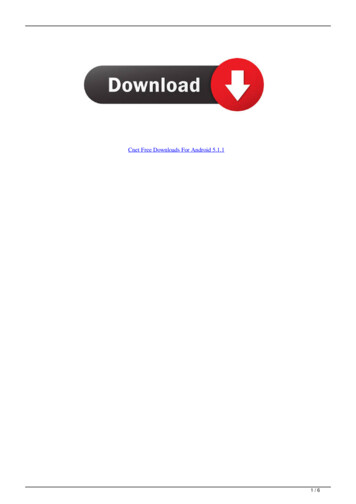
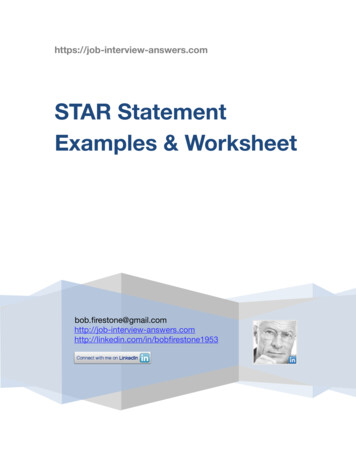

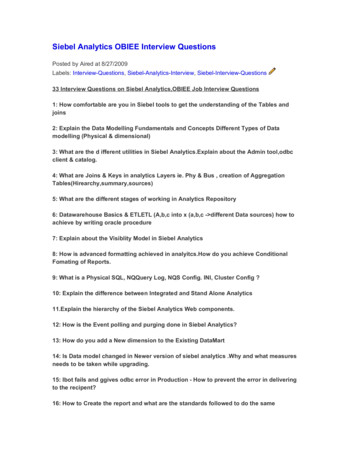

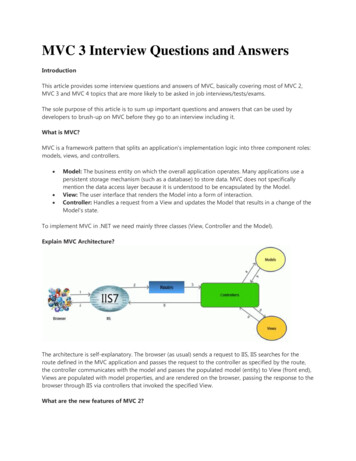
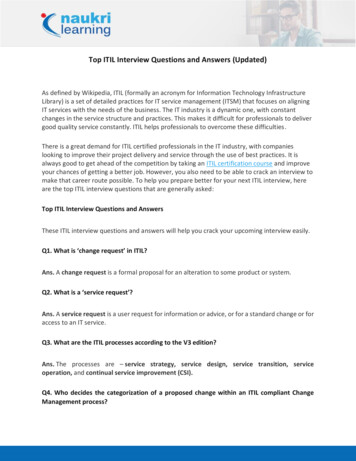



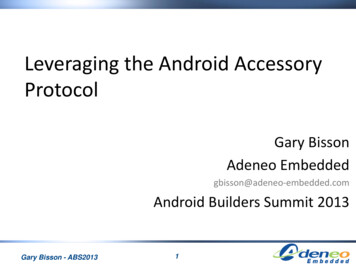
![Informatica Interview Questions and Answers [Scenario-Based]](/img/2/informatica-interview-questions-and-answers-scenario-based-1.jpg)